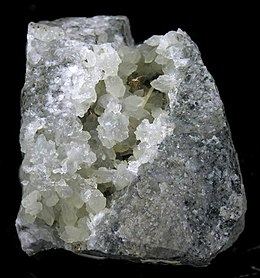| Krennerite | |
|---|---|
 Krennerite in a quartz vein, Cresson Mine,
Cripple Creek, Colorado | |
| General | |
| Category | Telluride mineral |
|
Formula (repeating unit) | AuTe2 to Au3AgTe8 |
| IMA symbol | Knn [1] |
| Strunz classification | 2.EA.15 |
| Crystal system | Orthorhombic |
| Crystal class | Pyramidal (mm2) |
| Space group | Orthorhombic H-M symbol: (mm2) Space group: Pma2 |
| Identification | |
| Color | Silver white to brass yellow (tarnish?) – creamy white (polished section) |
| Crystal habit | Massive to crystalline with short striated prismatic crystals |
| Cleavage | Perfect on {001} |
| Fracture | Subconchoidal – uneven |
| Tenacity | Brittle |
| Mohs scale hardness | 2.5 |
| Luster | High metallic |
| Streak | greenish grey |
| Diaphaneity | opaque |
| Specific gravity | 8.62 |
| Optical properties | Anisotrophism strong |
| Refractive index | Opaque |
| Pleochroism | weak |
| Ultraviolet fluorescence | None |
| References | [2] [3] [4] |
Krennerite is an orthorhombic gold telluride mineral which can contain variable amounts of silver in the structure. The formula is AuTe2, but specimen with gold substituted by up to 24% with silver have been found ([Au0.77Ag0.24]Te2). [2] Both of the chemically similar gold-silver tellurides, calaverite and sylvanite, are in the monoclinic crystal system, whereas krennerite is orthorhombic.
The color varies from silver-white to brass-yellow. It has a specific gravity of 8.62 and a hardness of 2.5. It occurs in high temperature, hydrothermal environments.
Krennerite was discovered in 1878 near the village of Săcărâmb, Romania, and first described by the Hungarian mineralogist Joseph Krenner (1839–1920). [4]
See also
References
- ^ Warr, L.N. (2021). "IMA–CNMNC approved mineral symbols". Mineralogical Magazine. 85 (3): 291–320. Bibcode: 2021MinM...85..291W. doi: 10.1180/mgm.2021.43. S2CID 235729616.
- ^ a b "Handbook of Mineralogy" (PDF). Archived from the original (PDF) on 2021-03-03. Retrieved 2017-05-09.
- ^ Krennerite Mineral Data on Webmineral
- ^ a b Krennerite: Krennerite mineral information and data om Mindat
- G. Tunnell and K. J. Murata, American Mineralogist 35, 359–384 (1950).
- Structure of Krennerite retrieved 6-26-05
- Euromineral retrieved 6-26-05
Wikimedia Commons has media related to
Krennerite.